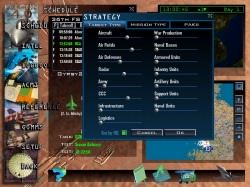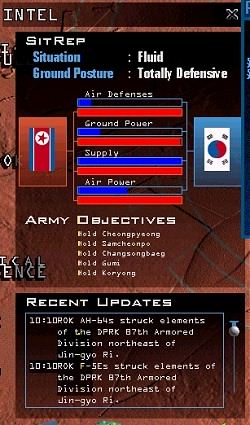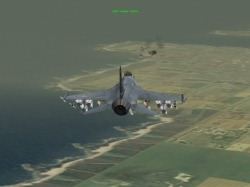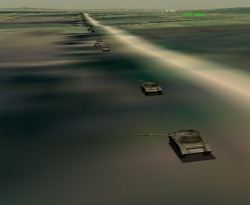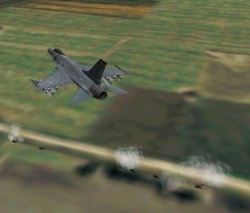By: Glenn 'Sleepdoc' Kletzky MD
Date: 1999-01-06
I had the distinct pleasure of interviewing one of the key programmers of Falcon 4.0 today. His name is Kevin Klemmick. After talking with Kevin for more than 90 minutes (we were scheduled for 30), I concluded a few things that shape this article.
First and foremost (and I had the same feeling about the co-producer, Steve Blankenship), I concluded that these guys are truly gentlemen. They are sincere and enthusiastic, and they genuinely enjoy talking to the customers and press people in their field.
I attended E3 in Atlanta in 1998, and I know "hype" when I see and hear it. This is not to say that there is no "hype" behind Falcon 4, because all products have " hype". But Kevin is a gamer and a programmer, not a marketing guy. And his demeanor and candor were completely refreshing. Kevin never once attempted to blind me with "hype", or sing "the party line". He is a straight shooter, and was willing to divulge the good, the bad and the ugly. This made him very credible in my book. I was genuinely impressed with his enthusiasm for the game, and the honesty and pain which he reflected on as we discussed Falcons past, present and future.
I have decided to write up this interview in a less than traditional format. I will depart from the usual "Q&A" format. It's not my style. But I recorded our interview, and this article will be written directly from the recording. Those of you curious about what we can expect in the next few months in regard to his area of the game (The TE mission builder, the Ground war elements of TE, and multiplayer in general) should read on.
Kevin is a 29-year-old guy whose passions for gaming (and multiplayer gaming to be specific) date back to the days of BBSs 10 years ago. He actually wrote a multiplayer BBS game that was well known in San francisco called "Land of the Lost". He made his initial contacts in Silicon valley with members of the team that he works with today. He was raised in Virginia, and his education included 7 years at the California Polytechnic Institute of Pomona, where he studied Aerospace engineering and Computer Science. He also was a member of ROTC and had some army training.
Kevin is the longest standing member of the Falcon 4.0 team, and has been working on the project for 4 years. He was originally hired to design a "dynamic campaign". He speaks fondly of the early days, when that was a big "buzz word". We laughed together that it is more of a buzzword today than ever. He was free to listen to players and enthusiasts, and develop his own idea of what makes a campaign truly "dynamic".
As most of you are already beginning to see as you play it, he truly does understand "dynamic campaign" as the scholarly players in our field (like the meticulous Jeff "Rhino" Babineau and that crazy Cajun, Pierre "PAPADOC" Legrand) think it to be. After all, it is the true players like these (no matter how different their style may be) who ultimately define these terms. Klemmick listened. He knew what it meant for a campaign to take on a life of it's own, where every mission was "thought up and designed" by the AI on the fly, as a result of the prior missions.
Kevin gave me some technical insight as to how the AI runs that I found very interesting. He realized early on that a single level AI would never produce a "real world" feel, because in the real world, decisions in the military are made at many different levels. In his attempt to understand and then reproduce military (and human) thinking, he made a multi-tiered AI system. You can imagine a room full of 5-star Generals with a big "battle board" making "big picture" decisions, such as "We need to take Seoul". He calls these decisions "hi level".
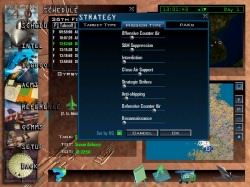
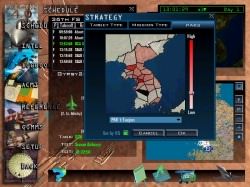
Strategy Selection Option
Screens. Click for Larger Image.
Clearly, there are many hi level decisions being made simultaneously in a Falcon 4 campaign, following a plan of attack with an "ultimate goal" in mind. Each campaign has its "ultimate goal" and they are pretty well spelled out for you in the little movies that introduce each campaign. In fact, the concept of a "mini-campaign" in the TE editor also has its "ultimate goals". They are set up in the "victory conditions" screen. As you read on, you will begin to realize that the TE editor utilizes many, but not all, of the multi-tiered AI subsystems of the campaign. Those parts that it does not use, the human mind is left to replace.
This is where things get very dynamic and very interesting. I once read on the Newsgroups one guy griping that the campaign couldn't be dynamic, because every time he starts the campaign, he gets the same set of missions. He couldn't be more wrong. A chess game between 2 humans is as dynamic as a campaign can get. It NEVER plays out the same way twice. It twists and winds around every move and countermove. And yet it still needs a standard starting point.
Every chess game ever played started with the exact initial setup. The 3 campaigns currently available for Falcon 4 are analogous to 3 different chessboard setups at the start of the game. And the 3 different ways to win (in one game, you get the king, for example. In another, you eliminate all pawns and rooks.) Even real wars start at some balance of power and position of troops. No matter how many times you look at the initial pieces on a chessboard, the game takes on a life of it's own once the initial moves are made. This campaign is dynamic in exactly the way its most vocal fans wanted it.
Once these "hi level" AI decisions are made, they are passed down to the mid-level AI. This is kind of like the 1 star Generals in the field meeting with their battalion commanders and airforce leaders. "OK boys, in order to take Seoul, we need to create a corridor of entry for our planes and ground troops. Let's start by knocking out their radar and softening up the defenses in the area." Now the mid-level AI actually starts making decisions about what resources to utilize based on those available.
And remember, as the war moves on, resources change. A lot of guys even make their first move or two in chess the same way, but if they suddenly get their bishop whacked, well then. Things start to change, eh? You start re-evaluating your resources and possibly allocate more towards defensive maneuvering. Etc. Dynamic.
The mid-level AI in F4 generates the actual packages and flights based on modern doctrine in order to take the objective, but as the friendly AI responds (and you tip the balance of things by making an AI flight that otherwise would have been a failure now successful), things change. Resource allocation, whether to be defensive or offensive with remaining assets in a particular area, and the actual package/flight/ground war activities are assembled and assigned. No scripted missions here boys and girls. This is the essence of a dynamic campaign. (Ed . Note: you can also tweak these responses to suit your own priorities, as the screens above and mid right demonstrate).
The third or "low level" of the AI is analogous to the actual grunts and flyboys in the field reacting to the plan and their environment. Imagine the pilots in the briefing rooms, deciding how to lay out their waypoints for the flight they were assigned, and which actual targets (seen the target lists lately in TE?) to bomb at particular sights. What munitions to use. How to avoid detection based on current Intel. Etc. Also at this level, are the individual AI routines. Sure, they are brave, red blooded American heroes, but hey ! Everyone has his limits.
After all, if you are lining up the last 60 seconds of your GBU bombing run, waiting for that DLZ to come into the kill zone, and you hear a Mig-29 radar lock on your RWR, that's a real pickle! Are you gonna stay on course for 60 more seconds and just hope he goes away? I don't think so. What if you only had 15 seconds left and you hear the lock? What then? What if you get a "launch warning"? This is all happening at the low-level AI. We want our wingmen to act like soldiers. We want some crazy-ass, "they can't kill me" heroes. We want some cowards. But mostly, we want reasonable pilots. We want a mix, and we want the appropriate mix. You can imagine what a bear these AI routines must be.
What makes playing TE custom missions so intriguing, and so different from the campaigns, is that your brain must do some of the work at each level of the AI. You make the missions. You decide the packages and routes and objectives. And you fly. And when TE is a little more bug free (more great news on that later in the article), you will be able to play multiplayer missions where you actually compete against your friends in "Force on Force" Multiplayer missions. These types of missions will have exactly the same dynamic issues as a game of chess.
We (the players of TE missions) are in our infancy. We are still excited about "one shot" interesting missions like the ones I currently post on Combatsim. Fly and do something. Win or lose. This is the elementary school level of TE.
Graduate courses are soon to arrive. Soon we will see multiplayer games (this will even work fine over the internet with 2 players, maybe up to four in the future, we will see), where you generate flights and ground battle movements in real time, and try to accomplish some goals (simple or complex) as set out in the Victory conditions. After each flight, you get back to the TE screen, make another bunch of flights (better pay attention to your resources) and fly again.
Meanwhile, your multiplayer enemy is attempting to cut off your flank with his tanks and he is sending flights against you. Is the night getting late? No prob. Save it and pick up your little "mano a mano" pissing war later. Playing scripted TE missions are very challenging and fun, but those only scratch the surface of what can be done in TE. Chess anyone?
In my original article about how to use the mission builder, I gave my opinion of the ground war as far as TE missions were concerned. I referred to it as a limited, 2 waypoint, one trick pony. Actually, the term "retarded" rather than limited would better explain the reality of it. Basically, its as broke as broke can be.
In fact, it was so broke, that I had no way of realizing how close it was to being a very elegant and truly strategic part of play. Mr. Klemmick assured me that making the ground war a piece of the puzzle that you could use to strategic advantage would be fixed at least by the third patch cycle and maybe by this very next one. You will be able to not only generate flights, but also to order troops to make ground movements to occupy cities or even defend airbases that you took from the enemy so that they can not easily take them back. You will actually be able to take the war to them on the ground.
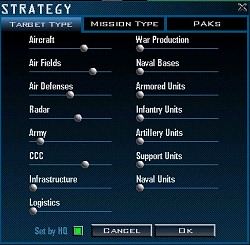
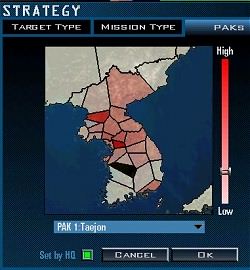
I was also very excited to hear Mr. Klemmick say something that may surprise many of you. He said that even though campaigns are fun, and they will play out differently every time, it is his personal feeling that TE is the part of the game that will ultimately give the this sim its great longevity. Because no matter how many ways a war to take North Korea plays out, it is still the same objective.
TE allows for infinite objectives and infinite possibilities to match the desires and creativity's of the gamers who design the missions. He said that no matter what state TE may appear to be in now (I'm gonna give it a C- for implementation and a A for concept) the next few months will bear out the commitment that MPS has to insuring that TE gets fixed to honor role status.
He made a VERY STRONG statement of commitment to, not only F4, but specifically to the TE mission builder module. I remember once asking a cardiac surgeon whom I was scrubbed in with if he could show me the cockles. He didn't laugh (those heart guys are so serious). But hearing this commitment for TE truly warmed the cockles of my heart (wherever the hell they are).
The interview was long, and I'm gonna stop here so that people can read this first part now. More to come soon. Mr. Klemmick goes on to discuss the mysterious and elusive "bubble" in clear detail, the bugs in the TE mission builder that they are hot on the trail of and a lot of good and reserved things about multiplayer. He goes on to talk about the beta testing process as well as the signal to noise ratio on the newsgroups.
He also talks about the "slow framerate in campaign issue", which he said he was actually putting his Sherlock Holmes onto today. Remember the whole "time on target" conundrum for the TE mission builder? We talk more about those as well (he knows he can get those licked).
I heard nothing but motivation from the people at MPS, and I know that they will incrementally come through.
Now go to Part II (below) of this report on my interview with Mr. Klemmick.
Part II: Player Bubble
For those of you who read the article on my interview with Kevin Klemmick, I hope you got a new understanding of the deep seeded AI of Falcon 4.0. In this second part of the article, we move on to the subject of the mysterious and elusive "player bubble". Many people on the newsgroups have been hypothesizing about what it is, and finally, we get the true answer. Oddly enough, the hypotheses put forth were either completely wrong or only part way down the road to the correct answer. I found the answers from the man who "made it so" (sorry for that, I'm a trekkie) to be quite interesting. If you like to understand the deep inner workings of your favorite sims, then this article is for you.
As an aside, we also discussed at great length the ground war element of the TE mission builder. In part three of this article to be released soon (give me a break guys, this stuff is really time consuming !!), I will reveal some very exciting and promising news on the topic.
The ground war is broken in TE right now, but Kevin was so confident (and excited) about the ground war element of the TE mission builder, that he told me exactly what we can all expect once it is patched. He also was confident that it would be nicely fixed at least by the third patch (we are expecting the next one early in February as per Mr. Louie's post on the newsgroups). I will also tell you about the implementation interface for the ground war we can expect. It is nothing like the broken thing we have now. Now back to the subject of this article, the "player bubble".
Mr. Klemmick noted to me that the bubble is not as "imprecise" as people think it is. We have all seen attempts by players to explain and understand the "player bubble" and many people on the Newsgroups believed that once a battalion of tanks left your bubble, it no longer existed at all, or at least, the individual tanks of the battalion were no longer tracked.
Many hypothesized that calculations relating to battles between tanks outside your bubble were reduced to much simpler calculations. Surprisingly, Kevin corrects us all on that. He stated that every single tank in the game and every enemy/friendly force encounter is tracked, whether or not it is in your bubble. The difference is that the individual units increase their "granularity" (his word) and they actually become "discrete physical entities" (again, his words), once they enter the player bubble.
Let me explain. Tanks and planes etc, exist as individually tracked items throughout every mission no matter if they are in or out of the bubble. They decide what they are going to do and then they do it. The results are scored no matter where they are. If a tank battalion decides that it detects an enemy tank, and it fires on it, and he hits it, that tank is registered as damaged. All these things occur in real time.
What DOES NOT happen, however, is what defines the meaning of a bubble. If you are outside the bubble, the game in no way develops a drawn object to be seen on the screen. Remember, if an object is "beyond visual range", you can still commit CPU cycles to fully draw and texture it, and then scale it to the visual distance. Of course, once the computer has done all that and then scales it to your viewing distance, it has calculated to draw the thing at less than 1 pixel large, so it decides to not draw anything!!
So why in the hell would you commit CPU cycles to calculate the fully textured and articulated polygon image if the end result is that nothing can be seen on your monitor at its current resolution, based on your viewing distance? The answer is, you wouldn't. And that boys and girls, is the first point. If you feel I am getting down to the nitty gritty of programming here, and you are wondering why I'm boring you, then stop reading right now. Because this IS all about programming. That's what Mr. Klemmick is. A programmer. If you are intrigued, then read on.
Ok, so now you understand that you will waste boodles of CPU cycles trying to draw things you can't see anyway if you don't have a bubble. Intuitively then, you should also see that as the bubble gets larger, more things must be drawn, even if they can't be seen. And there is more "CPU overhead" to drawing objects than just the initial draw. You must continue to calculate "how to draw them" for every subsequent frame. The turrets swing to fire. They fire and they smoke and blaze. They run across the landscape, animating their movement and blowing up dust. And every step of the way, you have to draw them.
It's one thing to calculate and store in memory the movement of an object and it's behaviors and responses. It's an entirely different thing to pile on top of that, the 3 dimensional, gourad shaded, texture mapped, dynamically lit, alpha blended vehicle itself with all it's special effects and animated movements. Klemmick said that his AI tracks "literally tens of thousands of ground objects and thousands of aircraft all the time" (his exact words), and in the campaign, often many of those objects are flying, fighting, thinking and planning all over the map at one time. That is daunting to say the least. Can you imagine ?
Furthermore, he goes on to say that the "granularity" of an object not only involves drawing it, but it also gets an "individual AI brain" and departs from a more "battalion or flight minded AI" that was controlling the "calculation only" tanks and planes outside the bubble. So clearly, with thousands of objects potentially in your bubble at any one time, removing a few can dramatically return CPU cycles back to your processor.
Before I tell you this next tidbit, I must warn you now (because I promised Kevin that I would). I am about to tell you the hard coded reality of what the actual "bubble distances" are in this game. He hesitated when I asked because he feared that I might "destroy the illusion" for people by letting them know exactly what distance an object becomes a physical entity on the screen, and leaves the realm of "in the memory only". I didn't share this concern, but he had it, so I am going to respect his wishes. IF YOU THINK IT REALLY MATTERS TO YOU, THEN SKIP THE REMAINDER OF THIS ARTICLE. JUST STOP READING NOW.
Before I reveal the actual numbers to you, you should understand, however, why I think it does not "destroy the illusion". Remember Klemmick said that objects are tracked but not drawn outside your bubble? And that battalions pull from a "battalion AI" and not an "individual unit AI" to direct their actions? Well don't you worry my boy, because that battalion or wing or whatever, can still fire at your complacent, "he's-not-in-my-bubble" ass.
SAMs that exist outside your bubble will still utilize a "group AI" and they will detect you and fire on you. And brother, when that SAM leaves "not-in-your-bubblesville" and makes its way into your bubble, that's one object the CPU ain't gonna have to animate for long. It is now a "physical entity". And although the ground unit that fired that SAM is not yet a "physical entity", you won't be thinking much about your damn bubble when that launch warning gives you an adrenal squeeze. I highly suggest you keep your mind off the bubble and put it on the incoming missile.
The point is this. The "illusion" of the bubble is really no illusion at all because units outside your bubble engage each other. And more importantly, units outside your bubble can still engage YOU. And once their missiles leave their "in-memory-only-launchers", they are gonna bust YOUR bubble if you don't get tight and fly right.
Ok. Enough bubble babble. Lets get to the numbers. He told me that the bubble for air units and the bubble for ground units are different. When you reduce your bubble to 1, for ground units, you are essentially reducing the player bubble to about 8 nautical miles. If you recall, and you read the manual, MPS says that "visual range" in this sim is about 8 nm. That is why you can only "padlock" out to 8nm. He could not recall the maximum range for ground units, but its probably about 40 nm.
He went on to say that the bubble of 1 for air units was about 40 nm. And when you max out your air unit's bubble, you reach out to about 80 nm. Many Techno-hackers who have diddled with the files have discovered "hacks" for the bubble size. Some have made the bubble very small (less than one) so that they can fly F4 campaign on their relatively under powered machines without taking such a massive framerate hit. They are unloading the CPU. Plain and simple. Smart guys out there.
So all this "bubble babble" leads us to an interesting question. If you can't see anything outside of 8 nautical miles, then why on God's green earth would you need a bubble adjustment option at all? Just shove everything beyond 8nm out of the bubble, and pull everything within 8nm within my bubble. Why let the user adjust it at all?
Well, because this ain't no dog and pony show people. There is something going on here we have totally neglected to mention thus far. It is one of the premier features of this sim that further validates the hyped statement "new Benchmark". I am speaking of the ACMI.
How many of you have really tinkered with the potential of this incredible module? You haven't lived until you sat on the rails of a SAM launcher, looking through the eyes of the very SAM that swung around from 60 miles out, and launched to knock your rocket ass out of the sky. And the fact is that if that SAM were outside your bubble when he swung around (still on the ground) you would not be able to view him (but you would be able to view the missile once it launched.
Interesting note here. All missiles, no matter how far out of your bubble they are, become physical entities once they leave the launch site or aircraft rails). For that matter, if you are in a multiplayer game, and you are all excited to watch how your buddy bombed Sinan-ni while you were off CAP'ing at some distant airbase, you better check that bubble son. If his bombing run occurred outside of your bubble while you had the ACMI set to "record", then you didn't record it.
But what is amazing, is that if your LAN/Internet buddy was inside your bubble, you won't miss a lick. So we see here that the ACMI file which is being filmed in real time only accounts for those objects within the players bubble. And truly, it makes sense to do it this way. They give you the option of how much of the world you really want to record.
Hmmm? I wonder aloud now. If you are recording a plane that is inside your 40 - 80 nm "air object bubble" and he bombs a ground unit that is simultaneously outside of your 8 - 40 nm "ground unit bubble", then will it appear on ACMI as if that plane is bombing the empty ground? Anyone wanna test this one and let me know? I'll also ask Klemmick next time we speak. Curious, huh?
To recap, 3 main things occur when a unit enters your bubble.
1. A unit inside your bubble is drawn in all it's glory (at least the work necessary to draw it on screen is completed) with all its articulated, moving parts, and all the visual effects that occur as a result of it's actions.
2. It receives a fully individualized AI brain (although it did have a "battalion or flight level brain" before)
3. It becomes "granular" to the ACMI, and therefor has been recorded on the ACMI file in full motion and action detail.
A typical example of where you can start to recognize granularity is on the air radar. Have you ever locked up a target at 80 nm, but when it gets inside of 40nm, you start to see that the single blip on your radar is slowly looking like 4 separate blips? That's the "flight entity" outside the bubble converting to a higher "granularity" and becoming individual "physical entities" inside your bubble. People with bigboy horsepower machines won't ever have the opportunity to notice this unless they turn down their bubble.
Most of us love to crank up all the options and leave it there. The event is so subtle, it is practically meaningless, and can be viewed as simply a flight at distance not being individually discernable by the radar at distance. So, IMHO, all this knowledge better helps us to satisfy our urge to know as much as we can about Falcon 4.0, but in no way destroys any "illusions" for you. It certainly doesn't for me. Actually, all it does is impress me with the complexities needed to create a great sim.
I hope my review of Mr. Kevin Klemmick's explanation of the "player bubble" has demystified it for you. The next part of the interview, which I will cover in the next article, will be about the amazing potential of the ground war element of TE. How we will soon be able to play mini-campaigns and issue not only new flights, but new ground war objectives "on the fly".
I can't wait to get completely destroyed by Jeff "Rhino" Babineau in a multiplayer battle (he was a real tank commander and actually knows about ground war tactics. He is also the guy that got me going on TE. Jeff… you have created a monster!). That's the beauty of the ACMI. After he spanks me, I can go back and study his tactics. Who knows? Maybe I will actually learn something for once. I better keep my bubble wide open so I can record all his tricky moves !
Sleepdoc out !
Part III: Force on Force
In this, the third part of the Klemmick interview, we discuss the "Force on Force" multiplayer option (term copyrighted by Jeff "Rhino" Babineau, 1999, patent pending) of the TE mission builder. It is, as of yet, mostly undiscovered. I believe this to be true for a couple of reasons.
The main reason, I believe, is because the ground war mission interface of TE is badly broken, and the bugs relating to it are essentially insurmountable. I tinkered with it for hours, and performed experiments with it, which clearly proved this to me. And even if it were not broken, I believe that it is the natural progression of a product such as this, that the users will discover these deeper features later. Most guys are still learning the more basic elements of the game. But, as with any game, time passes, we get better, and we start delving deeper into these features.
Together with Jeff "Rhino" Babineau of the 209th Deltahawks, and our own Eric "Snacko" Marlow of the 303rd Sidewinders (Remember him? He's the guy with the great articles on F-15 tactics), we spent hours screwing around with the ground war element of the game. As a real tank battalion staff officer, Tank Company XO, and tank platoon leader during his military career, "Rhino" was greatly interested in this feature. As a guy who loves competitive, multiplayer strategy games (I was hooked on Battlezone for longer than I should admit to the hardcore sim crowd), I too found this element very exciting. We were hell bent together for a couple of nights trying to understand how it really worked.
What we discovered is that the ground war element of TE is a mess. Don't even try it. You will be essentially wasting your time. It isn't even documented correctly as it stands now, and it will make you lose your mind as you try to add moving ground war elements to your missions. Yes, you can do it, and yes, sometimes they will go where they are told.
But ultimately, the ground forces will incorrectly start pulling from the Campaign AI engine (which they are not supposed to do in TE, you are supposed to be the AI), and they will start re-issuing themselves orders which you have no control over. Further more, in the context of a TE mission you just designed, those new orders will only confirm to you that the AI battalion commander is suffering from a combination of severe Schizophrenia and late stage Alzheimer's. Suffice it to say, it is as broken as broken can get.
But don't despair my ground war friends. Kevin Klemmick assures me that the fixes will be forthcoming soon. He said we would probably see some significant repairs in this next one or two patches, and those should make the dream take form very nicely. He even went further to say that the commitment to the TE mission builder was very high in the company, because most people believe it is this module alone which will give the series its greatest longevity and replayability.
So Kevin chose to reveal to me the actual way the ground war element will work in the near future (and he was very confident that those bugs are repairable). In order to better understand the function, we must place it in the context of an example. The actual interface specifics of controlling the ground war will be spelled out in detail in my next article. This article, however, is designed to explain (as Kevin explained it to me), how the concept of the "Force on Force" multiplayer option will play out.
In order to truly realize the full nature of the ground war feature, we must choose an example which uses all its features. Lucky for Mr. Babineau and myself, that example is the arrangement which we find the most compelling: the "Force on Force" multiplayer game. All that we discuss here also applies to the more limited "one shot mission" types like the ones we have been seeing a lot of lately on the net. My "Sleepdoc's situation" mission and the one I work you through in my mission builder article all fall in the "one shot mission" category.
In a "Force on Force" Multiplayer mission, a template is created rather than an actual mission. Here is what I mean by that. In the "one shot" type mission, the designer/editor of the mission sets up specific flights and packages (and soon ground war movements complete with battalion objectives) for both sides of the game. The player who downloads the "one shot" type mission then plays it out. He jumps into the F-16 flight of his choice (for either side, so long as that side has pre-designated flights which include F-16s), and flies the missions that the designer created for him.
He gets jumped or intercepted by whatever defending flights the mission designer built in. One way or the other, he flies the missions in the allotted time in order to attempt to achieve the "victory conditions" set forth by the original designer. Eventually, even if the mission had many flight opportunities for the flyer, the allotted missions run out, and the victory conditions are either achieved or not. Game over.
Granted, some "one shot" mission types include a few, simple packages and are determined by a few, simple victory conditions. Other, more complex "one shot" type missions include tons of flying opportunities and a complex set of victory conditions which must be met as you fly flight after flight. However, both these types of "one shot" missions have a common element which allow me to group them both as the "one shot" type. And that is that YOU did not design the missions, and that YOU did not issue the orders to your ground troops. You had absolutely nothing to do with the strategy for winning the mission.
Much like in the Campaign mode, you are nothing more than a grunt in this man's war, and you do as your told. You don't determine the makeup of the packages or the movement of the ground elements. You simply choose from the missions set forth to you by the Brass, and do your duty as a soldier, all the time having faith that the Big Brass have made the correct decisions for you. This describes the essence of what I term the "one shot" mission type.
Not so in the "Force on Force" type multiplayer game. Remember I said that these missions consist of a "template" and no actual missions? This is what I mean. When you start a "Force on Force" type multiplayer mission, you will NOT SEE A SINGLE FLIGHT for you to fly. What you will see, however, are a series of resources for you to pull from, so that you (you are the Brass and the flyboy here) can design your own flights, packages and battalion moves. You tell the ground forces where to go and what to do when they get there.
In fact, you could sit at the game interface for the entire time of the game, and never once fly. You could simply give orders to ground units and design packages to fly, and let the AI do the rest. You could play the entire war without once ever entering the actual 3d world. That's kind of silly, because we are flight sim fanatics, but you could do it. You could just sit there (knowing all along what the conditions for victory are) and read all the news updates and watch the Intel reports (which appear as enemy icons on the map) and move your pieces around like chess pieces. And if your planes get shot down, or your tanks get destroyed, you have lost that "resource" for the remainder of the match.
PLANES AND TANKS etc. ARE NOT RENEWABLE THROUGHOUT THE COURSE OF A TE MISSION !!! You get what you get, and that is ALL you get. So one means of beating your compadre could be through winning the war of attrition, but if in the process of winning the war of attrition, you neglect to achieve the victory conditions set forth by the designer of the mission, then you have no bragging rights. It's a stalemate. (Where is Henry Kissinger when you really need him ?!?!?!)
A typical "Force on Force" multiplayer game would progress as follows (much like a game of chess, only with louder explosions). Each player of a team (and you can have up 7 teams with their own starting territories) will have a specific amount of starting resources. In order to keep our example basic, this game will have 2 teams and each team will have 10 tank battalions, 10 mobile SAM battalions, 1 F-16 squadron, 1 F-15 squadron (Mig-29 for the enemy side) and 1 F-14 squadron (SU-27 for the enemy side).
They will all be placed at starting locations around the map within their respective friendly territories. Furthermore, a fairly complex set of victory conditions have been set forth, and can be reviewed by all players from within the game by simply going to the victory conditions window to read them.
Again, in order to keep our example less complicated, we will make up a simple set of victory conditions. In order for the commies to win, they must occupy the city of Seoul with at least 3 Tank Battalions (ok…I'm gonna spice it up a little now). However, for every 5 aircraft they lose, they must add one more tank battalion to the capture of Seoul in order to achieve the points necessary for victory. (hell, even my simple example invokes images of complexity, but if you liked simple, you would be at the arcade dropping quarters).
Also, lets imagine that a reverse but comparable set of victory conditions apply to the Good Ol' US of A, but of course the capture of some Northern city is the basis for victory. Now we have defined equal starting resources and winning objectives for each side.
Of course, our example mission was designed to be balanced, but nothing says it has to be. You could just as easily define a starting point for your chess game where one side has far greater resources but has a very difficult task for victory, while the weaker side has far fewer starting resources, but need only fend of your attack for 24 hours in order to win (as if they were waiting for reinforcements). Only the imagination of the initial mission designer limits the nature of the competition. Cool, huh?
An aside is in order here. The last paragraph may have led you to wonder just exactly what the limits of a victory condition entry is, and just how complex and convoluted those entries can become. You may also be wondering just how many separate victory conditions you can stack in a single mission. Stay tuned. I am only beginning to discover new tricks in that section of T.E. and once my investigation is over, I will be releasing an article which hopefully teaches all these elements, and supplements my original "TE Mission Builder Guide".
I have already discovered more than a few tricks (which are definitely not documented) concerning the ins and outs of this very powerful subsystem of the T.E. Mission builder. Sorry to leave you hanging, but I have ton of articles I want to write, and this stuff is very time consuming. I will try to do that one as soon as I finish this interview series I'm into right now.
Ok. Back to our example mission. So now we have our chessboard all set up and ready to go. Each team has a limited set of resources with which to play and a well-defined set of victory conditions defining their ultimate goals.
When you first start the game (you are playing for the USA and your rebellious friend is playing for the DPRK) neither of you has any flights set up or ground forces on the move, just a bunch of ground forces awaiting orders and a bunch of pilots sitting around drinking latte's at their respective airbases waiting for the General (that's you, bubba) to start organizing and authorizing packages to get their butts up in the air and fight. You know what you need to do to win. You know that the other guy is trying to do the same to you. You know that you can never replace a lost resource like a downed aircraft or a destroyed tank. Time to rock !!!
Quickly, you tell a few of your SAM battalions to reposition near your airbases to protect them from certain attack . You start telling your tanks to move toward the objective city. You worry however about an all out blitz. What if you get caught enroute, and the bridges are blown? You won't know till you get there. Then you will be annihilated at the bottleneck by enemy anti-tank flights !!
So you decide to feign an attack from the east, all the while intending to sneak the mass of your forces to the west. You pay careful attention to terrain, bridges and bottlenecks, so as not to get caught with your pants down. 30 quick mouse clicks later you have put your ground forces into motion and you start to generate packages and flights.
You know that any flight, which flies near an enemy battalion, will cause that flight to appear on your map (This is how updated Intel is modeled in the game). So you set up a series of alternating recon flights. You also know that their appearance on your map is the "last seen position" and that info gets old after 15 minutes, so you make sure you have a bunch of alternating flights to keep the recon fresh and up-to-date.
You decide that the bridge north of Seoul needs to be cutoff to protect Seoul, but you must first get your western most battalion across the bridge, so you send them racing with a package designed to protect them until they get across the bridge. You also send out a package to bomb the bridge after they cross.

Once you like the initial first moves you have made, you realize it will take at least 20-30 minutes for those tanks to get to their new locations. So you decide to be a flight leader in the flight to bomb the bridge. This way you can see with your own eyes when your boys are across, and also control the entire element through your "element commands" section of the sim. You are satisfied with your initial moves, and so you fly.
Your tanks get safely across, and you pound the bridge into steak tar-tar. You are in business!! Or so you thought. You land that bird and return to the interface only to find out that your enemy has moved his troops across bridges far to the east, and managed to destroy the lone battalion you sent as a diversion. Further more, the enemy tanks are now across the DMZ and have no more bridges between Seoul and themselves. You can only assume they are on an all out run for Seoul, but your last known positions are getting stale. You quickly generate new recon flights and new anti-tank missions along their suspected route.
But what if they dipped south in order to evade and be less predictable? What if they split into 3 groups? Maybe you can bring your remaining southerly tanks up in attempt to slow them down in a protracted ground engagement until you get there. You do just that, and boy! When you do finally find those sneaky bastards you witness an amazing battle !! Tow missiles lighting across the terrain! Shell fire blasting along the ground! But no time to watch the fireworks son. You have work to do.
You lock the enemy tanks on GMT radar. Or so you think. The fog of war has you confused. Are you about to commit fratricide (friendly fire)? The radio calls are almost too much to follow. Finally, you confirm that the targets are hostile, you issue the orders to your wing to attack, and all hell breaks loose. The radio calls are insane. Explosions and AAA aim to distract you. But you stay focused. So long as you still have a maverick on your rails, no T-62 is safe. What's this? Holy Moses !! They brought a mobile SAM battalion with them.
Damn! You didn't think about that possible strategy. Too late to add a SEAD escort to your package now. Launch !!!
I don't know about you guys, but when I realized that this level of play was gonna soon be possible, I got a chill up my spine. Sure, the term "New Benchmark" is a marketing "hype" term, but hey. Sure sounds like one to me.
In my fourth article coming soon, I will explain in detail the actual ground forces interface that will soon be available for use so that you too can live the mission I just described. Kevin Klemmick told me how it is going to work, and related a little of his personal embarrassment at the current state of that element of TE (He is a perfectionist, and he is having to accept the same hard reality that all of us are growing to accept : If you want the most complex, realistic flight sim ever built, you have to have patience for it all to come together). He even suggested (but did not state outright) that they were considering pulling TE from the initial release until all these bugs were fixed.
But in a wise decision made by the team, they chose to give us what they had so that we could enjoy it for what it was worth in its current state. They assumed (an in my opinion, they assumed correctly) that due to the vast depth of the TE mission builder, users would be better off learning to use those parts that worked now. He was confident that once they did, they would gladly stay tuned for the additional parts.
From my perspective, they were spot on. Despite all the bug hopping and craziness of the whole TE mission building thing, I have flown some incredible custom built missions that people have created, and all I can keep hearing myself say is "GIVE ME MORE !". Don't worry folks. More is on the way.
Stay tuned for Part four of this interview entitled "The ground war interface of the TE mission builder". Exclusively on COMBATSIM.com.
Sleepdoc out !
